For Sale!
Historic Seattle is selling the Egan House.
Historic Seattle is selling the Egan House.
Each year, Historic Seattle honors outstanding people and projects in preservation at our Annual Preservation Celebration. To do this, we need your help!
We want to hear from our entire preservation community about what preservation projects YOU think are worthy of celebrating. The deadline to submit is Friday, May 10.
Preservation is a Public Benefit
In the past month and a half, preservation supporters in Seattle came together to advocate for maintaining the integrity of the landmark designation process. Since 1973, the City of Seattle has designated approximately 450 landmarks that are subject to protection by the Landmarks Preservation Ordinance (LPO). Ostensibly, the recent controversy revolved around the landmarked Seattle-First National Bank Building (SFNB), located at 566 Denny Way in Uptown, but it became much bigger than that one landmark.
Background
The Seattle-First National Bank Building was designated a Seattle landmark in 2006 under four (out of six) designation standards, a strong statement by the Landmarks Preservation Board (LPB) in recognizing the significance of the building. The exterior and the site were included in the designation. Walgreens purchased the property in 2007 (one year after the designation), adapted the former bank into a retail store, and worked with the Landmarks Preservation Board to reach a Controls and Incentives (C&I) agreement in November 2021 that would apply to the site and exterior of the building. (Controls help to protect a landmark and economic incentives can help an owner maintain a landmark.) The final step in the landmark designation process is City Council approval of the designating ordinance and adoption of the C&I agreement.
Because the SFNB is located in the Uptown neighborhood of Queen Anne, it is eligible as a landmark sending site for Transfer of Development Rights (TDR). This is an important financial incentive that became available for Uptown only in the last few years. The owner can sell TDRs and use the money to maintain the landmark building. A developer who owns a property in Uptown that qualifies as a receiving site can purchase the TDRs to benefit their housing project by increasing FAR (and therefore, additional units). This is a win-win for preservation AND housing. It’s both/and, not either/or.
The Issue
OK, great! So, what was the problem? On December 9, 2022, the City Council’s Neighborhoods, Education, Civil Rights, and Culture Committee met to review Council Bill 120312 (an ordinance relating to historic preservation; imposing controls upon the Seattle-First National Bank Building). At that meeting, four members of the Committee questioned why the Seattle-First National Bank Building was landmarked (they did not believe it was significant), wondered what public benefit the landmark offered, and cited the need for more housing in Uptown, a dense urban neighborhood. Essentially, the Committee believed this landmark was getting in the way of more housing and they wanted to dictate the use on this privately owned property. However, the LPO does not give the LPB nor the Council authority to control use in a landmark building or site. The property is not for sale and there are no redevelopment plans for the site. Uses other than housing are also allowed on the parcel.
The Council Committee recommended to the full City Council that they reject the designating ordinance. We saw this recommendation as a major threat to preservation in Seattle and the City’s preservation program. Removing C&I would leave the landmark vulnerable to demolition and set a bad precedent that could undermine the landmark designation process for any designated landmark that does not have controls and possibly any future designated landmarks.
The Call-to-Action
CB 120312 was scheduled for the January 3, 2023 City Council meeting and then postponed for another week to January 10, 2023. Historic Seattle, the Queen Anne Historical Society, West Seattle-based advocates, the Washington Trust for Historic Preservation, and many individuals jumped into action in December and January to urge Councilmembers to honor the Landmarks Preservation Ordinance and designation process by passing the designating ordinance and adopting controls and incentives for the Seattle-First National Bank Building. A key message was that preservation and housing are not mutually exclusive—this is a false choice. It’s both/and, not either/or. We also supported a compromise that would place no controls on the parking lot north of the landmark building—making it easier for potential development. Council Central Staff provided an analysis of housing development potential on the parcel. It turns out that retaining the landmark could potentially yield more housing units on the site by using a combination of incentives, bonuses, and creative design of new construction. Detractors argued the parking lot is too small for a high-rise. We beg to differ given the many examples of high-rise residential construction on smaller or similar-size lots in this city.
The road to the January 10 City Council meeting was a wild one! There were three amendments to the original bill. The Council realized it could not de-list or “unlandmark” the building so the designation would remain. It is the role of Council to adopt, modify, or reject controls and incentives for a landmark. The Walgreens lawyer suggested to Council that they pass the designating ordinance but remove controls and incentives. So it became the battle of the amendments. Amendment A (proposed by Councilmember Tammy Morales) was to pass the designating ordinance but place no controls and incentives on the building and site (worst-case scenario in our minds). Amendment B (proposed by Councilmember Lisa Herbold) was to pass the designating ordinance and place controls on the exterior of the building and specific character-defining features on the site, but remove controls on the parking lot. Amendment C (proposed by Councilmember Andrew Lewis) supported Amendment B but would also remove the character-defining features on the site, effectively placing controls on the building, the site between the building and Denny Way, and the site between the building and 6th Avenue N. Are you still with us? Crazy, we know!
Historic Seattle supported Amendment B. And ultimately, we supported Amendment C. The result was City Council voted 9-0 for Amendment C which places controls on the landmark building’s exterior and the portion of the site between the building and Denny Way and between the building and 6th Avenue North.
Ultimately, Historic Seattle is happy with the outcome because City Council’s unanimous vote confirmed the longstanding landmark designation process. The Council’s role is not to “rubber stamp” but to confirm and respect the process. Historic preservation is a public benefit in and of itself and should not be pitted against other public policies. Only 0.5% of parcels in Seattle are designated landmarks or in historic districts. That is a minuscule amount in the grand scheme of the built environment.
A big thank you to all who contacted City Councilmembers advocating for the preservation of this modern landmark and for respecting the designation process. Every communication in support was important. Your voices were heard! Council President Debora Juarez’s recent weekly newsletter shows that Council received 124 letters in support of CB 120312 and the compromise amendments and 32 letters in opposition—four times more in support! Finally, we thank City Council for its final decision and particularly Councilmembers Herbold and Lewis for seeking a compromise solution that supports preservation of the landmark and maximizes housing potential.
Learn more:
Materials related to CB 120312
Feliks Banel, KIRO Newsradio, “Preservation groups: Seattle City Council making mistake with historic bank.” Click here to read or listen to this story!
Emma Hinchliffe, Daily Journal of Commerce, “Compromise reached in debate over future of landmarked Uptown bank building.”
We need YOU to urge City Council to vote in favor of Amendment B, a pro-housing and pro-preservation resolution, to the Controls & Incentives (C&Is) agreement for the Seattle-First National Bank (SFNB)* building at tomorrow’s January 10 Council Meeting at 2:00 PM!
Click here to read all supporting documents for the SFNB bill (CB 120312), including Proposed Amendment B. Sponsored by Councilmember Lisa Herbold, the amendment aims to meet demands from Council for housing development on the site while protecting and preserving the designated landmark by adopting C&Is for the building only:
“This amendment would remove the surface parking area on the north side of the Seattle-First National Bank building from the designated features of the landmark. Development would be permitted on the parking area, but controls and incentives would continue to apply to the building on the site, the sign post, the drive-through area, and landscaping between the building and the street.”
NOW is the time to Tell the Council that a vote in favor of Amendment B honors the Landmarks ordinance and process by adopting C&Is for the Seattle-First National Bank building and maximizes housing development on the parking lot:
Questions? Contact Eugenia Woo, Historic Seattle’s Director of Preservation Services, at eugeniaw@historicseattle.org.
*ICYMI: The Seattle-First National Bank Building (SFNB), located at 566 Denny Way in Uptown was designated a Seattle landmark in 2006. Walgreens purchased it after the designation, adapted the former bank into a retail store, and worked with the Landmarks Preservation Board (LPB) to reach a Controls and Incentives (C&I) agreement (in November 2021) that would apply to the site and exterior of the building. The last step in the landmark designation process is City Council approval of the C&I agreement, but some members of City Council seem to believe that preservation and housing are mutually exclusive. This is a false choice. It’s both/and; not either/or.
If this amendment to the C&I agreement is not adopted, the landmark will be vulnerable to demolition, setting a dangerous precedent for ALL future and current Seattle Landmarks without controls and disregarding a tried and true program (Transfer Development Rights) that allows preservation to be an asset in creating more housing within Seattle.
Feliks Banel with KIRO Newsradio has got it exactly right: Seattle City Council is making a mistake with the Seattle First National Bank Building (SFNB). Click here to read or listen to this story!
Having postponed the full council vote until Tuesday, January 10, City Council is still threatening Seattle’s robust landmarking process by not adopting already agreed upon Controls and Incentives (C&Is) for the SFNB. Instead, they may adopt an amendment, written up by the lawyers hired by Walgreens, to eliminate all controls and incentives. Some members of City Council seem to believe that preservation and housing are mutually exclusive. This is a false choice. It’s both/and; not either/or.
With the full council vote already delayed until January 10, NOW is the time to make your voice heard! Join us in telling the Council that denying C&Is for the SNFB:
A) sets a dangerous precedent for ALL future and current Seattle Landmarks without controls,
B) disregards a tried and true program (Transfer Development Rights) that allows preservation to be an asset in creating more housing within Seattle,
C) and insults our and your belief that preservation enriches the lives of all in Seattle.
AND, demand that City Council honor the Landmarks ordinance and process by adopting controls and incentives for the Seattle-First National Bank building.
Click here to review the 1/10/23 City Council Meeting Agenda, which includes three options to provide Public Comment to the Council:
Seattle City Council will vote in their January 3rd meeting (this coming Tuesday!) to adopt or deny Controls and Incentives (C&Is) for the Seattle First National Bank Building at 566 Denny Way in Uptown. A vote to reject these C&Is subjects this existing Seattle Landmark to NO protections and increases its vulnerability to demolition.
Join us in telling the Council that denying C&Is sets a dangerous precedent for ALL future and current Seattle Landmarks and demand that City Council honor the Landmarks ordinance and process by adopting controls and incentives for the Seattle-First National Bank building.
Click here to view the January 3, 2023 City Council Meeting Agenda, which includes the following options to provide Public Comment to the Council:
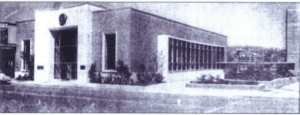
Seattle-First National Bank. Image credit: Construction News Bulletin, 1950.
Here’s the deal—we’re in a pickle: the Seattle-First National Bank Building (SFNB), located at 566 Denny Way in Uptown was designated a Seattle landmark in 2006. Walgreens purchased it after the designation, adapted the former bank into a retail store, and worked with the Landmarks Preservation Board (LPB) to reach a Controls and Incentives (C&I) agreement (in November 2021) that would apply to the site and exterior of the building. The last step in the landmark designation process is City Council approval of the C&I agreement, but we’re concerned Council may reject controls and incentives, thereby leaving the landmark vulnerable to demolition.
We need YOUR Help! Write to City Council before January 3 (ideally by December 23) and demand they honor the Landmarks ordinance and process by adopting controls and incentives for the Seattle-First National Bank building (reference CB 120312). A decision to reject controls and incentives for SFNB puts preservation and landmarking at risk! Contact all Councilmembers by emailing council@seattle.gov.
Context for said “pickle:” until recently, the SFNB has been declared as a building of significance (by virtue of its landmark designation), and a C&I agreement has been signed in which economic incentives are available to the property owner in exchange for committing to maintain the building.
You may recall from our ongoing Showbox advocacy efforts that landmark designation alone does not save buildings – controls and incentives are critical to protecting the places we love. The SFNB, having a designation and C&I agreement signed, means this building is well on its way to being preserved as an asset and public benefit to the City of Seattle. The final step is for the City Council to adopt Council Bill 120312.
OK, great! So, what’s the problem? On Friday, December 9, several members of the City Council’s Neighborhoods, Education, Civil Rights & Culture Committee met and challenged, without documentation or justification, the Seattle-First National Bank building’s landmark designation and the need to place controls and incentives on the building and site.
In advance of the meeting, Seattle City Council Central Staff provided the Committee with a 10-page memorandum detailing the landmarking process and recommendations for next steps. Additionally, the Committee received a joint letter of support for adopting controls and incentives for SFNB from Historic Seattle and the Queen Anne Historical Society.
The Council Committee’s recommendation to reject controls and incentives without reasons relevant to the Landmark Preservation Ordinance and in contradiction to the Landmarks Preservation Board (a group consisting of volunteers appointed by the Mayor and confirmed by City Council) is unprecedented and a major threat to preservation in Seattle and the City’s preservation program.
On Tuesday, January 3, 2023, Seattle City Council will decide whether to adopt the jointly agreed Controls and Incentives for the Seattle-First National Bank building. If rejected, the Council’s decision could undermine the landmark designation process for any designated landmark that doesn’t have controls and possibly any future designated landmarks.
This is NOT OK! Again, we urge you to write to City Council (council@seattle.gov) before January 3 (ideally by December 23) and demand they honor the Landmarks ordinance and process by adopting controls and incentives for the Seattle-First National Bank building (reference CB 120312).
Questions? Contact Eugenia Woo, Historic Seattle’s Director of Preservation Services, at eugeniaw@historicseattle.org.
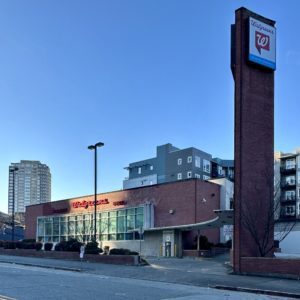
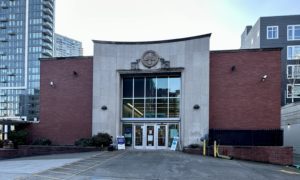
There are some things that are so obvious, they seem silly to state. The Pike Place Market is a Seattle icon. Yeah, we know. Yet, we truly take this for granted. In fact, Seattle’s icon was nearly flattened. It’s only because of the tireless work of community activists that you can enjoy the flower shops, bookstores, restaurants, produce stands, tchotchke vendors, and artist stands that have a home at the Market today.
This month’s VivaCity recognizes those activists who worked to “Keep The Market.” 50 years ago – on November 2, 1971 – the Pike Place Market was saved through a voter initiative. “By the early 1960s, the Market we know today had seen better days. Seattle’s mayor called it a ‘somnolent fire trap.’ Downtown business leaders and property developers were eager to use federal urban renewal fund to ‘renew’ the Market by demolishing it,” as Friends of the Market tells it.
That’s where “Keep The Market” stepped up, to fight a demolition plan and save the Market. Landmarking wouldn’t cut it. Seattle’s Landmarks Preservation Ordinance wasn’t codified until 1973.
So what did they do? “City Councilmember Wing Luke wrote a newspaper op-ed, calling for citizen action to preserve the Market. Architect Victor Steinbrueck and attorney Robert Ashley answered the call. In September 1964, they brought together sixty friends for a champagne breakfast to launch the effort in Lowell’s Café (still in the Market). Architect Fred Bassetti, unable to attend, wrote that the Market was ‘an honest place in a phony time,’” according to Friends of the Market.
The plan was to establish a 9-acre historic district that saved the Market. These days, Seattle has a number of beloved historic districts, but in its time this effort was groundbreaking. The story of the Market is captured in the film “The Market.” Watch it here.
The Market was narrated and produced by Bruce Chapman, who was elected to Seattle’s City Council in 1971. The film notes that activists “ran an initiative campaign to establish a Pike Place Market Historic District. Seattle’s voters passed it by a landslide. It was the first historic district ever created by a public vote, and it was the first historic district officially pledged to retain a place for the poor. It also was one of the first historic districts in America to manage uses of buildings as well as their appearances. It was one of the first successful efforts to incorporate historic preservation into urban renewal.”
We owe a debt of gratitude to the activists who saw a threat to a place they loved and fought to save it, with a vision that has changed preservation in the decades that followed.
And, happy golden anniversary of so many firsts, Seattle! How should we celebrate? The only appropriate way: a stroll through the bustling Market, picking up flowers and having a nice dinner from its iconic small businesses, of course.
For more information:
Read this great piece by The Seattle Times.
Tune in to the re-airings of Labor of Love: Saving Pike Place Market – dates listed here
A Memory of the Future film
Photo credit: Friends of the Market
Talk to anyone who has ever been a La Quinta Apartments resident about what it’s like to live in this Frederick Anhalt-developed building on Capitol Hill (1710 E Denny) and you will immediately hear stories of connection, accounts of really knowing your neighbors, and descriptions of a very close-knit community.
“La Quinta is a unique place where all of the neighbors grow close and really like spending time together… all of the people I have met there seem to genuinely want to make the place they live not just a home for themselves, but also a community where people look out for each other and become family,” said a friend of a La Quinta resident since the 1990s.
You may also hear descriptions about the magic of the courtyard, shared balconies, charming turrets, and a unique design that welcomes interaction.
“La Quinta is more than just gorgeous architecture. It’s a perfect place to be a writer, with plenty of beauty and solitude balanced with a supportive community just outside my door.” said Chelsea Bolan, a La Quinta resident since 2003.
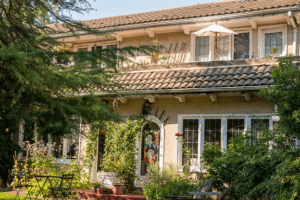
La Quinta Apartments from the courtyard. Photo by Jesse L. Young, Seattle.
Given all of this, it is no wonder why a group has come together with a well-coordinated effort to seek protections for this extraordinary place. Formed in late 2020, ¡Viva La Quinta! is a group of residents, neighbors, and allies (including Historic Seattle) dedicated to preserving La Quinta Apartments and making it a City landmark.
This month, we took the opportunity to talk to two people involved in ¡Viva La Quinta! Lawrence Norman, who grew up at La Quinta in the ‘60s, shares his unique connection to the place and the influence it had on his life trajectory. Chelsea Bolan describes what it’s like to live there today and tells us more about the group working to preserve La Quinta for generations to come.
“My father was a Black man and from Mississippi and my mother was a White woman from Alabama – they met at Boeing. He was an aeronautical engineer, and she was a mathematician and computer programmer. She actually programmed some of the first satellites!” said Lawrence Norman describing his origins at the La Quinta Apartments. He continued, “To an extent, I think some of the reasons they came to Seattle were to get as far away from the South as possible. They were pretty idealistic, and, at the time, Seattle was pretty radical.”
While It may have been radical in some ways, during that time (the mid-1960s) Seattle and many other “progressive” cities exercised an intentionally discriminatory practice known as “redlining.” In this practice, White people wrote racial exclusions into property deeds and community covenants, effectively prohibiting property ownership for Black people, Jews, and other people of color, beyond very limited areas bound by red lines.

Image from “The History of Redlining” by KCTS9 on YouTube.
Despite this very significant obstacle, Lawrence’s father Richard worked to purchase the La Quinta apartments by making a deal directly with the property owner at the time. “When he bought La Quinta in…1964, or 1965, it was just over the ‘red line,’” Lawrence explained. According to Lawrence, Richard was not new to real estate. “He had previously owned a property in the ‘Negro area,’ (as defined by redlining) and he’d owned another right on the line,” Lawrence says. Given the practices of those times, it is not surprising that Richard’s ownership had been reflected as a gap in the official records. You can read more about this, and other interesting aspects of the building’s ownership history in the landmark nomination report here.
Lawrence added, “My parents worked together at Boeing for a few years before starting a computing business out of La Quinta. Apartment 9 was home, and Northwest Computing was basically a startup, born out of apartment 10 — In 1965 of all things! I imagine it was probably the first Black-owned computing business in Seattle, but I can’t say for sure. The business lasted for like 8 or 9 years and it was pretty successful, with up to 18 or 19 employees at one point and an office downtown. But then the Boeing bust happened, and we lost it all. It was a painful time. That place is special to me and represents something totally personal.”

A turret at La Quinta. Photo by Jesse L. Young, Seattle.
Some of Lawrence’s earliest memories are from La Quinta. “I remember looking out of the turret into the courtyard from my room, and there were other kids there. I remember one in particular, a little girl who lived in apartment 4. Her room was also in a turret and I had a crush on her, it was pretty cute,” Lawrence recalled. “The community was tight-knit, there was an ease with the architecture. It’s a U-shaped building with everyone facing each other around the courtyard, making it almost like a little village. It’s also a refuge, peaceful and conducive to conversation. My dad was very serious about keeping that courtyard in good shape!”
Because of the Boeing bust Lawrence left La Quinta at age 7, but his time there would shape him in many ways and play into some of his life choices. “The Boeing bust was very real for me and my family. Losing La Quinta set me up to be more conservative in my own life,” he explained.

Lawrence Norman at La Quinta, age 7. Courtesy of Lawrence Norman
Lawrence would follow in his parents’ footsteps by pursuing a career in software. “I got a Bachelor of Science in Computer Science while I was at Evergreen, but I got distracted for a year by Architecture. When I ask myself why I was drawn to study architecture, I’d say it probably came from living in that building,” said Lawrence.
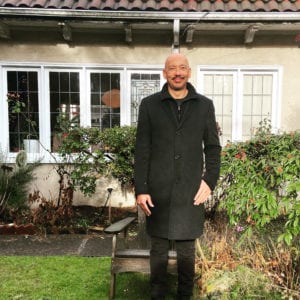
Lawrence at La Quinta in 2020.
Lawrence went on to compare software design and architectural design citing A Pattern Language, a popular book often included in both courses of study. “The book looks at everything from the big design down to a doorknob and asks, ‘what’s the optimal design for human functionality?’ I think La Quinta represents a ton of those design patterns. And when you get really geeky, you know that design patterns are also part of software design! Whether you’re trying to design a user interface or housing where people can coexist, some designs invite human interaction and some detract from it. The question is, ‘how do you want to structure these things so human beings can have the best experience?’ It applies to software, it basically applies to anything you’re building.”
In summarizing why La Quinta should be protected, Lawrence said, “It’s a unique piece of architecture whose scale and design promotes bonding between neighbors, and I’d like to see historical designation for it so that it could maintain its natural affordability instead of maximizing buildable volume.”
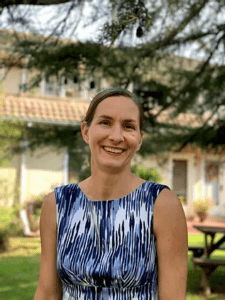
Chelsea Bolan, one of the founders of ¡Viva La Quinta! and resident since 2003.
¡Viva La Quinta! member Chelsea Bolan came to Seattle from Spokane in the 1990s to attend UW. She lived all over Capitol Hill in her early days here and remembers always admiring La Quinta and thinking “one day, if I could ever afford it…” In 2003, that day came, and Chelsea’s life has taken shape around La Quinta ever since.
“When I first moved in, I treated it like any other apartment building, where you’d be like, ‘Oh hi, nice to meet you,’ and go inside and never talk to your neighbors again. Within days, we had neighbors knocking on our door saying, ‘We’re having a BBQ, do you want to come out?’ and I just thought ‘Wow, this is amazing!’ I’d never had an apartment experience like that, with people who are really interested and really want to get to know you. That aspect of liking your neighbors, of being able to talk to your neighbors, and actually being friends – that has never changed since I’ve been here. One thing I’ve learned from this project (¡Viva La Quinta!), from talking with other people who lived here in the past, is that it was always this way,” said Chelsea.

Movie night in the courtyard.
“We have a lot of traditions and gatherings within, among just us and our friends. Sometimes it’s centered around food, like when we all made tamales together in a big assembly line in Aaron and Marta’s apartment, then ate them in the courtyard garden. We have one tradition that was started by someone who no longer lives here, someone who left over ten years ago. It’s based on the 12 days of Christmas since there are 12 apartments. It’s a roaming party where we spend 20 minutes in each person’s apartment, which is now organized by a neighbor who wasn’t even here when it got started. It’s gone on for years now and it’s interesting that it still works. The people change, but it’s always a mix of people who are interested in these things. I wonder if it’s the architecture that brings people out, because by design, we share so much space. I think the building just draws a certain kind of people too, people who are open to talking to each other.”
“There’s a lot of community within, but it extends out into the neighborhood and larger community in a lot of ways too. One example is our annual BBQ. Every year, we have a free community BBQ that is a fundraiser for a local nonprofit. We invite everyone in the neighborhood. People love it, and it’s a great opportunity to meet new neighbors.”
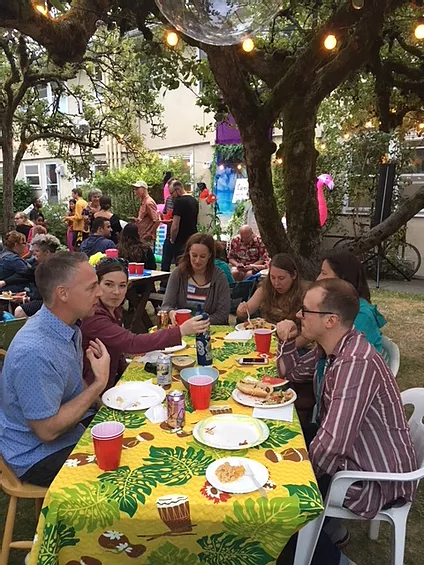
A community gathering at La Quinta.
In describing how ¡Viva La Quinta! came about, Chelsea said, “We heard from the apartment manager that the building was going to be coming up for sale. He wanted to let us know, in case we wanted to landmark it before it got sold. We said, ‘We’ve got to get on this!’ Someone sent an email around and we started planning. Word spread and neighbors came forward saying ‘We can help, we’ve done this before, we can put you in touch with the right people,’ and they connected us to Historic Seattle and then Historic Seattle contacted Northwest Vernacular (the firm that wrote the landmark nomination). It’s amazing, among us we have architects, photographers, writers, people who know how to build a website and do graphic design. Everyone just naturally came into a role, and it all came together. It was actually Jeff (Murdock, Historic Seattle’s Advocacy & Education Manager) who came up with the name ¡Viva La Quinta! It really captures the spirit we have, this lively spirit. And also, ‘Long live!,’ let’s keep this thing going!”
On why she thinks the La Quinta Apartments should be protected, Chelsea added, “The community that the place fosters is a big part of it, but it’s also just a great building. With its Spanish style, it is unique even among Anhalt designs. He made it feel like a home, more than just an apartment. There’s a thought toward individuality, every apartment is different, and there’s a lot of thought to detail from the layout to the fixtures. The courtyard too is valuable, especially as greenspace becomes more and more limited. It has provided so much to us during the pandemic. Both the community and the architecture are really important to preserve.”
Both Lawrence and Chelsea thought a co-op or a condominium ownership model would be beneficial in the long-term. “My dream for the place would be that everything that needs updating and attention would be fixed, and that after all of that, it would still be affordable.”
¡Viva La Quinta! Get involved!
Because of its significance to the community, Historic Seattle has prioritized the La Quinta as a major advocacy effort. A landmark nomination was submitted in October 2020. The Seattle Landmarks Preservation Board will consider the nomination at its February 3 public meeting.
You can help support the La Quinta preservation efforts! The ¡Viva La Quinta! website, created and maintained by the residents, is a great resource. Stay connected through the ¡Viva La Quinta! email list and Instagram. If you already follow Historic Seattle via eNews, Facebook, and/or Instagram then you’ll stay in the know as well.
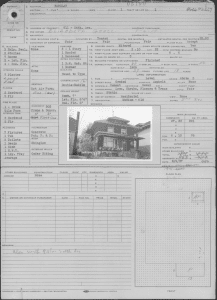 Congratulations to Wa Na Wari!
Congratulations to Wa Na Wari!Wa Na Wari is an active center for Black art and culture sited in a 5th-generation Black-owned home in Seattle’s Central District. The home, originally built in 1909, was purchased by Frank and Goldyne Green in 1951 and members of the extended Green family continued to reside there through 2013.
In 2016, Inye Wokoma became the estate guardian and put a plan in place to preserve and maintain the home in perpetuity. Establishing Wa Na Wari is the first step towards securing that long-term vision.
The Central District, a historically redlined neighborhood, was 80% Black in the 1970s. Today, gentrification has taken hold, with a population that is now less than 14% Black and dropping. Seattle’s affordability crisis has impacted residential, commercial, and cultural opportunities for Black residents and has all but eliminated spaces where Black artists can live, work, and create. Aging Black homeowners struggle to afford skyrocketing property taxes and remaining Black residents experience isolation and economic hardship.
for Black residents and has all but eliminated spaces where Black artists can live, work, and create. Aging Black homeowners struggle to afford skyrocketing property taxes and remaining Black residents experience isolation and economic hardship.
By providing space and resources for Black artists to collaborate, exhibit their work, and network with other artists, collectors, and patrons, Wa Na Wari is advancing the community in the face of such challenges.
Wa Na Wari was nominated for this award by Cynthia Brothers of Vanishing Seattle. “As a Black-led organization, Wa Na Wari is not only physically preserving a historic home – it is preserving Black culture, ownership, and the social connection which is integral to the neighborhood and to the city as a whole,” Cynthia said.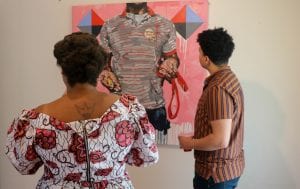
Wa Na Wari’s visionary usage of art and community stories both defends and creates space to sustain and reignite local Black cultural life. Furthermore, Wa Na Wari is actively demonstrating how Black art and culture can be effective tools for combating gentrification and displacement by securing Black-owned property for community use.
In the spring of 2020, Wa Na Wari launched a new program to help anchor the Black community in the Central District: The Central Area Cultural Ecosystem 21st Century (CACE 21). CACE 21 is a community organizing initiative that seeks to build grassroots power, expertise, and capacity among Black Central District homeowners and artists to envision and advocate for community-driven land use policies that fight d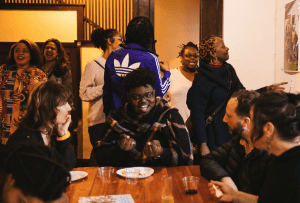 isplacement and lower the barriers to creating more cultural spaces, such as those based on the Wa Na Wari model.
isplacement and lower the barriers to creating more cultural spaces, such as those based on the Wa Na Wari model.
At a time when the Black heritage of the Central District is at risk of being erased, Wa Na Wari has taken the lead in protecting and enhancing its cultural legacy. For that, it is our privilege to present them with Historic Seattle’s 2020 Community Advocacy Award. This award includes a $3,000 prize which Wa Na Wari plans to use to support their homeowner advocacy work.
Featured image by Mujale Chisebuka; 3rd embedded image by Jill Freidberg
It took only a couple hours (if even that) to demolish the 122 year-old Sullivan House on Capitol Hill the morning of March 18. This historic home, prominently situated on the southeast corner of 15th Avenue and E. Olive Way, was a designated Seattle Landmark. The house was built in ca. 1898 for Patrick J. and Joanna Sullivan. P.J. Sullivan was the proprietor of Queen City Boiler Works before becoming involved in real estate development. The house was designed in the Queen Anne style by the prominent architecture firm of Josenhans and Allan, credited for designing notable works such as the Marion Building at 818 2nd Avenue, the C.C. Cawsey House at 325 West Kinnear Place West, as well as Lewis, Clark, and Parrington Halls on the University of Washington campus.
The property was listed for sale in 2017 for $2.2M, a price that did not reflect the decades of deferred maintenance of the house. It was a prime candidate for renovation and some TLC but the asking price was cost prohibitive, leaving the property vulnerable to market forces. Seeking a way to preserve the historic house, a Seattle architect and Capitol Hill neighbor submitted a landmark nomination application in 2017 without support from the owner (the owner’s consent is not required to landmark a building in Seattle).
The Sullivan House was designated a landmark by the Landmarks Preservation Board (LPB) in 2018. Its designation was supported by Historic Seattle and many in the Capitol Hill community. We supported the nomination and designation of the Sullivan House because it embodied the distinctive characteristics of the Queen Anne style, represented an outstanding work of the architecture firm of Josenhans and Allen, and was situated prominently at the southeast corner of 15th Ave and E Olive Way, presenting a striking contrast to surrounding buildings.
After the building was designated on February 7, 2018, the owner and the LPB staff entered into negotiations for a “Controls and Incentives” agreement. Controls are what protect a landmark’s designated physical features. Incentives are financial benefits and zoning and building code relief available to owners of landmarked properties. Historic Seattle advocated for controls to be placed on the Sullivan House through a detailed analysis and pro forma demonstrating that the property, as a designated landmark with controls, could still provide a reasonable rate of return to an owner or investor. We felt it was important to conduct this analysis because two other recently designated landmarks (the Galbraith House and the Wayne Apartments) had no controls placed on them, paving the way for demolition. We did not want to see another historic property face the same fate.
At its September 19, 2018 meeting, the Board voted to place controls on the property. This victory was short-lived, however, as the owner appealed the Board’s decision to the Hearing Examiner. In early 2019, the owner and the City of Seattle settled and controls were lifted – leaving no protections for the Sullivan House. The decision not to place controls was the result of a “Stipulation and Proposed Recommendation and Order” signed by the Hearing Examiner at the request of the City Attorney and legal counsel for the owner. The stipulation claimed that “Controls will prevent the Estate from realizing a reasonable return on the property…”
Historic Seattle strongly disagreed with this conclusion because we demonstrated to the Landmarks Preservation Board (in a public comment letter containing well-reasoned analysis) that controls would not prevent a reasonable return on the property. Real estate finance is not an exact science. What one developer finds to be an acceptable rate of return, another may find unacceptable. Other factors that come into play, such as market value, cap rate, comparables, etc. are all malleable.
The Sullivan House was the third landmark to be designated without controls in just over a year. The landmark Galbraith House (also on Capitol Hill) was demolished in January 2018 because it had no controls. It has now been over two years and the site of the Galbraith House is still vacant, as a replacement project has yet to be built. Controls were not placed on the landmark Wayne Apartments in Belltown in 2018, and its days are numbered as well because the property is for sale and may be under contract with a developer.
Until the last couple of years, it had been rare for the Board to place no controls on a designated landmark. We know these must have been difficult decisions for the Board and City staff. What’s not helping is the current, overinflated market value of properties in Seattle and the trend of “demolition-by-neglect” by owners who let their properties deteriorate to the point where rehabilitation is much more expensive than if the properties had been maintained over the years. If a developer or property owner can show no “reasonable economic use” for a designated property, then the death knell will surely sound for the landmark.
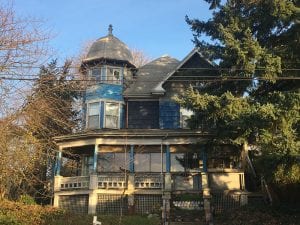
The deteriorating Sullivan House as it appeared toward the end of its life. Photo courtesy of Seattle Dream Homes.
The Sullivan House had been converted to a five-unit apartment building in 1949, offering affordable rents for 70 years until it was sold in 2019 to a private developer for just under $2.2M. A victim of neglect and development pressure, it will be replaced by eight townhomes which will be sold for market rate.
The demolition of the Sullivan House will not be in vain. We will learn from this as we work to protect other designated landmarks where controls are not yet in place, because this cannot be the new normal for our city’s historic places. Something needs to change. Historic Seattle and our community partners in preservation hope to work with the City to look for ways to improve the Landmarks Preservation Ordinance so that it can provide the legal protections needed for our city’s historic places.
Historic Seattle’s landmarking of The Showbox is now in the controls and incentives phase. We are doing all we can to demonstrate that as a designated landmark with controls, the Showbox property will still provide an owner or investor reasonable economic use. Landmarks deserve protection, not plaques.
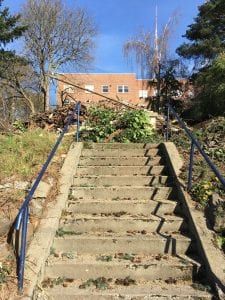
The “stairs to nowhere” on the site of the now-demolished Sullivan House